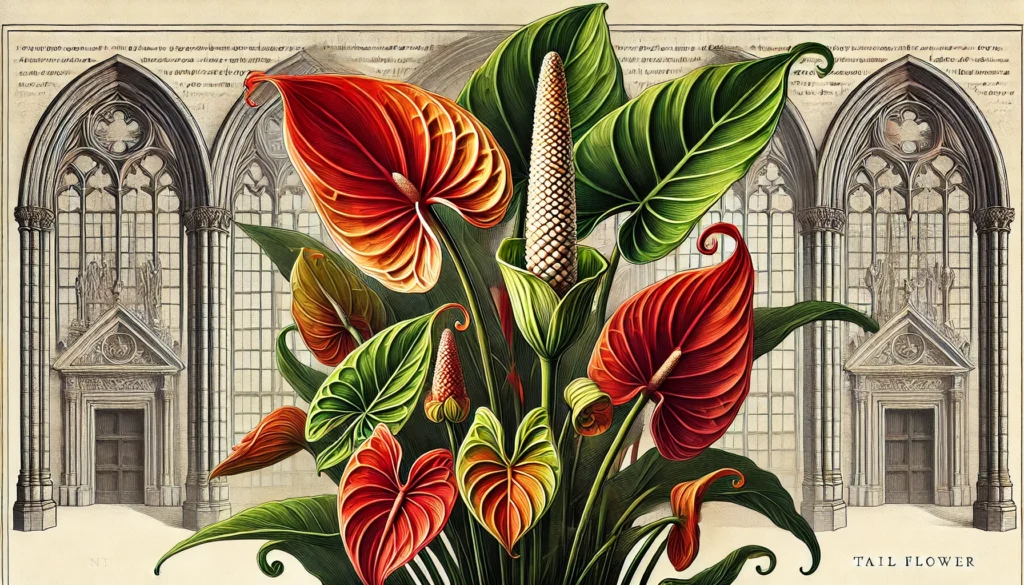

Home » Cat Plants » What Makes the Tail Flower Plant Dangerous for Cats?

The Anthurium plant, also known as the Tail Flower or Flamingo Lily, is a popular houseplant that can be dangerous for cats if ingested. While cats are not necessarily allergic to Anthuriums, these plants contain insoluble calcium oxalate crystals that can cause severe irritation and inflammation in the mouth, throat, and digestive tract.
Anthurium plants are commonly found as indoor ornamental plants and are native to the tropical rainforests of South America, particularly in the region between southwestern Colombia and northwestern Ecuador.
Ingestion may cause mild gastrointestinal upset, but is generally not life-threatening.
Ingestion can result in mild symptoms like vomiting, diarrhea, or drooling. Rarely fatal but may require veterinary care.
Eating these plants can lead to more pronounced symptoms like abdominal pain, lethargy, or difficulty breathing. Veterinary intervention may be necessary.
Ingesting even small amounts can cause severe symptoms like organ damage, seizures, or cardiac failure without rapid treatment.
All parts of these plants are extremely poisonous to cats and can quickly lead to death, even with immediate veterinary care.
** Please note: Please note that toxicity level can vary based on the amount ingested and the specific cat. It's always best to keep these plants completely inaccessible to cats and seek immediate veterinary care or call the poison hotline if you suspect your cat has ingested any part of a toxic plant.
If a cat ingests any part of an Anthurium plant, it may experience various symptoms due to the calcium oxalate crystals present in the plant’s tissues. These crystals can cause:
In severe cases, kidney failure may occur if a large amount of the plant is consumed.
If you suspect your cat has ingested an Anthurium plant, it is crucial to seek veterinary care promptly. Your veterinarian will likely follow these steps to diagnose and treat your cat:

A: Yes, the Tail Flower plant (also known as Anthurium) is harmful to cats. It contains insoluble calcium oxalate crystals, which can cause severe irritation in the mouth, throat, and digestive tract if ingested.
A: Symptoms of Tail Flower plant poisoning in cats include drooling, vomiting, and difficulty swallowing. If your cat shows these signs, seek veterinary care immediately.
A: The Tail Flower plant is moderately toxic to pets, particularly cats and dogs. Ingestion can lead to significant discomfort, requiring prompt medical attention to alleviate symptoms.
A: Cats can recover from Tail Flower plant poisoning with timely veterinary intervention. However, the severity of the symptoms can vary, making early treatment crucial for a full recovery.
A: It is not safe to keep a Tail Flower plant in a house with cats due to its toxic properties. Consider non-toxic alternatives like Boston ferns or spider plants to keep your cat safe.
A: If your cat ingests a Tail Flower plant, contact your veterinarian immediately. Prompt action is necessary to manage symptoms and prevent more serious health issues.
The Tail Flower plant is native to the tropical rainforests of South America, particularly in the area between southwestern Colombia and northwestern Ecuador.
These plants remained untouched for centuries, with little interest from native people, possibly due to their less attractive appearance compared to the cultivated varieties we see today.
In the late 1930s, a businessman named Samuel Samon introduced Anthuriums to Hawaii. People then learned to propagate Anthuriums through seeds, leading to the development of various cultivars with different shapes and colors through selective breeding.
By the 1940s, Anthuriums had become an economically valuable plant in Hawaii and gained popularity among tourists. With the advent of air travel, Anthurium cultivation transformed into an international business.
Please note: The information shared in this post is for informational purposes only and should not be considered as veterinary medical advice.
🐾 A hilarious or heart-melting cat video
🐾 Our latest paws-on review of a cool cat toy